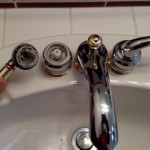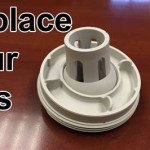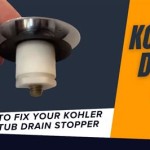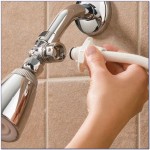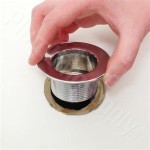Why Is Water Coming Out From Under My Bathtub Faucet?
Discovering water leaking from under a bathtub faucet can be a concerning and potentially damaging issue. The presence of water where it shouldn't be often indicates a problem within the plumbing system connected to the faucet. Identifying the source of the leak and understanding the potential causes are the first steps toward addressing the issue and preventing further damage to the bathroom and surrounding areas.
This article will explore several reasons why water might be appearing from underneath a bathtub faucet, providing insights into possible diagnoses and offering general guidance on how to proceed. It is, however, critical to emphasize that complex plumbing repairs are best left to qualified professionals. Attempting repairs without the necessary knowledge and tools can exacerbate the problem and lead to more extensive and costly damage.
Loose Connections and Fittings
One of the most common reasons for water leaking from under a bathtub faucet is loose connections or fittings within the faucet assembly or the pipes connected to it. These connections, which are typically threaded joints sealed with plumbers tape or pipe dope, can loosen over time due to vibrations, changes in water pressure, or simply the natural degradation of the sealant. The constant expansion and contraction of pipes due to temperature fluctuations in the water flowing through them can also contribute to loosening.
The water supply lines leading to the faucet, whether they are copper, PEX, or galvanized steel, connect to the faucet body through fittings. If any of these fittings are not properly tightened or if the sealing material has deteriorated, water can escape. This water doesn't always immediately manifest as a leak at the connection itself. It can travel along the pipe or within the surrounding structure before appearing as a puddle beneath the faucet. The specific location of the leak's emergence can thus be misleading.
To inspect for loose connections, it’s usually necessary to gain access to the plumbing behind the bathtub, which might require removing an access panel or a section of the wall. With the water supply shut off at the main shutoff valve or the individual shutoff valves (if present) for the bathtub, carefully examine each connection point. Look for signs of water staining, corrosion, or mineral buildup, which can indicate a past or present leak. Gently try to tighten the fittings with a wrench, but avoid excessive force, which can damage the pipes or fittings. If a fitting is severely corroded or damaged, it may need to be replaced entirely.
If the leak originates from within the faucet body itself, accessing the connections might require disassembling the faucet. This should only be attempted with the water supply shut off and with a clear understanding of the faucet's construction and how to properly reassemble it. Faucet repair kits are often available for specific models, containing replacement O-rings, washers, and other components that can address internal leaks.
Damaged or Deteriorated Faucet Components
Aside from loose connections, the faucet itself might contain damaged or deteriorated components that are causing the leak. Faucets are comprised of various internal parts, including O-rings, washers, cartridges, and valve seats, all of which are subject to wear and tear over time. The constant flow of water, mineral deposits, and the chemical properties of the water can gradually erode these components, leading to leaks.
O-rings and washers, which are rubber or silicone seals, are particularly vulnerable to degradation. They can become brittle, cracked, or deformed, losing their ability to create a watertight seal. This is especially common in areas with hard water, where mineral buildup can accelerate the deterioration process. When an O-ring or washer fails, water can seep past it and escape from the faucet body, potentially appearing as a leak underneath the faucet.
Cartridge-style faucets, which are increasingly common, contain a cartridge that controls the flow and temperature of the water. If the cartridge becomes damaged or clogged with mineral deposits, it can malfunction, leading to leaks or inconsistent water flow. Replacing the cartridge is usually a straightforward process, and replacement cartridges are readily available at hardware stores. To identify the correct replacement cartridge, it’s often necessary to know the faucet's model number or manufacturer.
Valve seats, which are the surfaces against which the faucet valves close, can also become corroded or damaged over time. If the valve seat is not smooth and even, the valve will not be able to create a watertight seal, leading to a leak. Repairing a damaged valve seat can be more complex, requiring specialized tools and expertise. In some cases, it might be more cost-effective to replace the entire faucet rather than attempt to repair the valve seat.
Diagnosing a faucet-related leak involves carefully examining the faucet body for any signs of damage, such as cracks or corrosion. It also requires disassembling the faucet (with the water supply shut off) to inspect the internal components for wear and tear. Replacement parts can often be purchased individually or as part of a faucet repair kit. When reassembling the faucet, it's important to follow the manufacturer's instructions carefully and to use appropriate lubricants to ensure a proper seal.
Plumbing Leaks Within the Wall or Floor
In some cases, the water appearing under the bathtub faucet might not be directly related to the faucet itself. Instead, it could be a sign of a more significant plumbing leak within the wall or floor surrounding the bathtub. These leaks can be more difficult to diagnose and repair, as they are often hidden from direct view.
A leaking pipe within the wall or floor can occur due to corrosion, damage from nails or screws, or simply the aging of the plumbing system. Copper pipes, while durable, can develop pinhole leaks over time, especially in areas with acidic water. PEX pipes, while more resistant to corrosion, can still be damaged by improper installation or physical trauma. Galvanized steel pipes are particularly susceptible to corrosion and can eventually develop leaks due to rust and mineral buildup.
The water from a hidden plumbing leak can travel along the pipes or within the surrounding structure before emerging in an unexpected location. It might seep through the wall or floor and appear as a puddle under the bathtub faucet, even though the actual leak is located several feet away. This makes it challenging to pinpoint the source of the problem without a thorough inspection.
Identifying a hidden plumbing leak requires careful observation and potentially the use of specialized tools. Look for signs of water damage, such as discoloration, stains, or bubbling paint on the walls or ceiling. Listen for the sound of running water when all faucets and appliances are turned off. A moisture meter can be used to detect elevated levels of moisture in the walls or floor, which can indicate the presence of a leak.
In some cases, it might be necessary to cut into the wall or floor to access the plumbing and locate the leak. This should be done with caution to avoid damaging other pipes or electrical wiring. Once the leak is located, it can be repaired by patching the pipe, replacing a section of pipe, or using specialized leak-sealing products. However, significant plumbing repairs should be left to qualified professionals to ensure that the work is done correctly and that the plumbing system is properly restored.
Furthermore, prolonged exposure to hidden water leaks can result in mold growth, structural damage, and potentially compromise the air quality inside the bathroom. It is crucial to address any indications of a hidden leak promptly to prevent secondary issues. Even if the cause isn’t directly related to the faucet itself, the presence of water warrants investigation.
In summary, water appearing from underneath a bathtub faucet can stem from various causes ranging from simple loose connections to hidden plumbing leaks. Thorough investigation and systematic elimination of potential causes are key to resolving the issue and preventing further damage.

Water Leaking From Under The Bathtub Possible Causes And Solutions

How To Fix A Leaking Bathtub Faucet The Home Depot

Plumbing Why Does My Shower Head Drip When The Tub Faucet Is On Home Improvement Stack Exchange

How To Fix A Leaking Bathtub Faucet The Home Depot

How To Fix A Leaking Bathtub Faucet The Home Depot

Fix Tub Spout That Leaks Water When Shower Is On

Shower Diverter Problem Can Be Quickly Fixed Home And Garden Life

Why Is My Bathtub Faucet Leaking After The Water Turned Off Ranshaw

Shower Runs When Tub

How To Fix A Bathtub Faucet From Leaking Dripping 3 Steps Everyday Home Repairs
Related Posts



